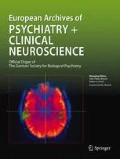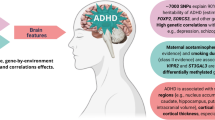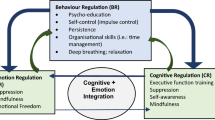Abstract
Objective
This exploratory study aims to compare lifetime psychiatric axis-I-comorbidity and psychosocial functioning in a clinically referred sample of adult patients with attention-deficit/hyperactivity disorder (ADHD) with a population-based healthy control group and to examine whether patients with ADHD and lifetime comorbid diagnoses differ from patients with pure ADHD in their functional impairment.
Method
Seventy adult patients with ADHD according to DSM-IV criteria and a gender- as well as age-matched population based control group underwent diagnostic evaluations with clinical interviews for ADHD, DSM-IV disorders and demographic information.
Results
The prevalence of psychiatric lifetime comorbidity was 77.1% in patients with ADHD and thus exceeded the rate in the control group, which was 45.7%. Significantly more patients suffered from depressive episodes, substance related disorders and eating disorders. Compared to the control group adults with ADHD were significantly impaired in a variety of psychosocial functions (education, occupational training). Patients with ADHD and lifetime diagnosis of comorbid psychiatric disorders differed from patients with pure ADHD in their psychosocial functioning only in the percentage of unemployed individuals, which was higher in patients with psychiatric comorbidity.
Conclusion
Adults with ADHD suffer significantly more often from other psychiatric disorders than individuals of the population-based control group and are impaired in several areas of psychosocial functioning. Poor psychosocial outcome is primarily related to ADHD and not to additional psychiatric disorders. Due to the limited number of assessed patients these results need to be confirmed by studies with larger sample size.
Similar content being viewed by others
References
Akiskal HS, Burgeois ML, Angst J, Post R, Möller H, Hirschfeld R (2000) Re-evaluating the prevalence of and diagnostic composition within the broad sprectrum of bipolar disorders. J Affect Disorders 59:S5–S30
American Psychiatric Association (1994) Diagnostic and Statistical Manual of Mental Disorders, 4th edn. American Psychiatric Press, Washington, DC
Barkley RA (2002) Major life activity and health outcomes associated with attention-deficit/hyperactivity disorder. J Clin Psychiatry 63(12):10–15
Berger M (1999) Affective disorders. In: Berger M (ed) Psychiatry and psychotherapy. Urban & Schwarzenberg, München, Wien, Baltimore
Biederman J, Faraone SV, Spencer T, Wilens T, Norman D, Lapey KA, et al. (1993) Patterns of comorbidity, cognition and psychosocial functioning in adults with attention-deficit hyperactivity disorder. Am J Psychiatry 150(12):1792–1797
Biederman J, Wilens T, Mick E, et al. (1995) Psychoactive substance use disorders in adults with attention deficit hyperactivity disorder (ADHD): effects of ADHD and psychiatric comorbidity. Am J Psychiatry 152:1652–1658
Brown TE (1996) Brown attention-deficit disorder scales manual. The Psychological Corporation, San Antonia
Curran S, Newman S, Taylor E, Asherson P (2000) Hypescheme: an operational criteria checklist for molecular genetic studies of attention deficit and hyperactivity disorders. Am J Med Genet 96(3):244–250
Dukarm CP (2005) Bulimia nervosa and ADHD: a possible role for stimulant medication. J Womens Health Gend Based Med 14(4):345–50
Dwivedi KN, Banhatti RG (2005) Attention deficit/hyperactivity disorder and ethnicity. Arch Dis Child 90(1):10–12
Fangerau H, Ohlraun S, Granath RO, Nöthen MM, Rietschel M, Schulze TG (2004) Computer-assisted phenotype characterization for genetic research in psychiatry. Hum Hered 58:122–130
Faraone SV, Biederman J (1998) Neurobiology of attention-deficit hyperactivity disorder. Biol Psychiatry 44:951–958
First M, Spitzer R, Gibbon M, Williams J (1997) Structured clinical interview for DSM-IV axis-I disorders (SCID-I). American Psychiatric Press, Washington, DC
Geller B, Zimmerman B, Williams M, Bolhoffer K, Craney JL, et al. (2000) Diagnostic characteristics of 93 cases of a prepubertal and early adolescent bipolar disorder phenotype by gender, puberty and comorbid attention deficit hyperactivity disorder. J Child Adolesc Psychopharmacol 10:157–164
Gillberg C, Gillberg IC, Rasmussen P, Kadesjö B, Söderstöm H, Rastam M (2004) Co-existing disorders in ADHD—implications for diagnosis and intervention. Eur Child Adolesc Psychiatry 13(Suppl. 1):80–92
Horn W (1962) Leistungsprüfsystem. Verlag für Psychologie, Göttingen
Hornig M (1998) Adressing comorbidity in adults with attention-deficit/hyperactivity disorder. J Clin Psychiatry 59(7):69–75
Kent L, Craddocok N (2003) Is there a relationship between attention deficit hyperactivity disorder and bipolar disorder? J Affect Dis 73:211–221
Kessler RC, Adler L, Barkley R, Biederman J, Conners CK, Demler O, et al. (2006) The prevalence and correlates of adult ADHD in the United States: results from the National Comorbidity Survey Replication (NCS-R). Am J Psychiatry 163(4):716–723
Kessler RC, Berglund P, Demler O, Jin R, Walters E (2005) Lifetime prevalence and age-of-onset distributions of DSM-IV disorders in the National Comorbidity Survey Replication. Arch Gen Psychiatry 62:593–602
Kooij JJS, Burger H, Boonstra AM, Van der Linden PD, Kalma LE, Buitelaar JK (2004) Efficacy and safety of methylphenidate in 45 adults with attention-deficit/hyperactivity disorder. A randomized placebo-controlled trial. Psychol Med 34:973–982
Manuzza S, Klein RG, Bessler A, et al. (1993) Adult outcome of hyperactive boys. Educational achievement, occupational rank, and psychiatric status. Arch Gen Psychiatry 50(7):565–567
McGough JJ, Smalley SL, McCracken JT, Yang M, Del’Homme M, et al. (2005) Psychiatric comorbidity in adult attention deficit hyperactivity disorder: findings from multiplex families. Am J Psychiatry 162(9):1621–1627
Murphy KR, Barkley RA, Bush T (2002) Young adults with attention deficit hyperactivity disorder: subtype differences in comorbidity, educational and clinical history. J Nerv Ment Dis 190(3):147–157
Nierenberg AA, Miyahara S, Spencer T, Wisniewski SR, Otto MW, et al. (2005) Clinical and diagnostic implications of lifetime comorbidity of attention-deficit/hyperactivity disorder in adults with bipolar disorder. Data from the first 1000 STEP-BD participants. Biol Psychiatry 57(11):1467–1473
Perkonigg A, Wittchen HU (1995) Epidemiology of anxiety disorders. In: Kasper S, Möller HJ (eds) Anxiety and panic disorders Fischer, Jena, Stuttgart, pp 137–156
Rasmussen P, Gillberg C (2000) Natural outcome of ADHD with developmental coordination disorder at age 22 years: a controlled, longitudinal, community-based study. J Am Acad Child Adolesc Psychiatry 39(11):1424–1431
Retz-Junginger P., Retz W, Blocher D, Stieglitz R-D, Georg T, Supprian T, Wender PH, Rösler M (2003) Validity and reliability of the German short version of the Wender–Utah rating scale for the retrospective assessment of attention-deficit/hyperactivity disorder. Nervenarzt 74:987–993
Rösler M, Retz W, Retz-Junginger P, Hengesch G, Schneider M, Supprian T, et al. (2004) Prevalence of attention-deficit-/hyperactivity disorder (ADHD) and comorbid disorders in young male prison inmates. Europ Arch Psychiatry Clin Neurosci 254:365–371
Satterfield JH, Schell A (1997) A prospective study of hyperactive boys with conduct problems and normal boys: adolescent and adult criminality. J Am Acad Child Adolesc Psychiatry 36(12):1726–1735
Schweickert LA, Strober M, Moslowitz A (1997) Efficacy of methylphenidate in bulimia nervosa with comorbid attention-deficit/hyperactivity disorder. Int J Eat Dis 21:299–301
Secnik K, Sneusen A, Lage MJ (2005) Comorbidities and costs of adult patients diagnosed with attention–deficit hyperactivity disorder. Pharmacoeconomics 23(1):93–102
Shekim W, Asarnow RF, Hess E, et al. (1990) A clinical and demographic profile of a sample of adults with attention deficit hyperactivity disorder, residual state. Compr Psychiatry 31:416–425
Spencer T, Biederman J, Wilens T, Doyle R, Surman C, Prince J, et al. (2005) A large double-blind, randomized trial of methylphenidate in the treatment of adults with attention-deficit/hyperactivity disorder. Biol Psychiatry 57:456–463
Sullivan MA Rudnik-Levin F (2000) Attention-deficit/hyperactivity disorder and substance abuse: diagnostic and therapeutic considerations. Ann N Y Acad Sci:251–270
Ward KF, Wender PH, Reimherr FW (1993) The Wender Utah rating scale: an aid in the retrospective diagnosis of childhood attention deficit hyperactivity disorder. Am J Psychiatry 150:885–890
Weiss G, Hechtman L, Milroy T, et al. (1985) Psychiatric status of hyperactives as adults: a controlled prospective 15-year follow-up of 63 hyperactive children. J Am Acad Child Adolesc Psychiatry 24:211–223
West S, McElroy, Strakowski S, Keck P, McConville B (1995) Attention-deficit hyperactivity disorder in adolesecent mania. J Affect Disord 51:145–151
Acknowledgements
We would like to thank Uwe Ruhl, Georg-August-Universität, Göttingen, for making us the use of the German version of the Brown attention deficit disorders scales available.
Author information
Authors and Affiliations
Corresponding author
Rights and permissions
About this article
Cite this article
Sobanski, E., Brüggemann, D., Alm, B. et al. Psychiatric comorbidity and functional impairment in a clinically referred sample of adults with attention-deficit/hyperactivity disorder (ADHD). Eur Arch Psychiatry Clin Neurosc 257, 371–377 (2007). https://doi.org/10.1007/s00406-007-0712-8
Received:
Accepted:
Published:
Issue Date:
DOI: https://doi.org/10.1007/s00406-007-0712-8




